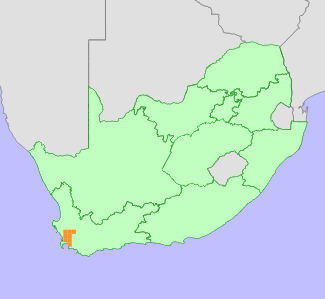|
Scientific Name | Aristea lugens (L.f.) Steud. |
Higher Classification | Monocotyledons |
Family | IRIDACEAE |
National Status |
Status and Criteria | Endangered B1ab(i,iii,iv); C2a(i) |
Assessment Date | 2021/02/22 |
Assessor(s) | D. Raimondo |
Justification | This Western Cape endemic has a restricted distribution, with an extent of occurrence (EOO) of 2064 km², and an area of occupancy (AOO) of 168 km². It has lost over 90% of its habitat over the past 200 years. It now remains on small fragments within agricultural and urban areas. Remaining subpopulations are severely fragmented and continue to decline due to urban and agricultural development, alien plant invasion, a lack of fire and loss of pollinators associated with fragmentation. We estimate that there are fewer than 2500 mature individuals extant, with all recently surveyed subpopulations containing fewer than 250 mature individuals. It is therefore assessed as Endangered under criteria B and C. |
Distribution |
Endemism | South African endemic |
Provincial distribution | Western Cape |
Range | This Western Cape endemic has a restricted distribution occurring from Riebeek-Kasteel and Malmesbury to Stellenbosch. |
Habitat and Ecology |
Major system | Terrestrial |
Major habitats | Swartland Shale Renosterveld, Swartland Granite Renosterveld, Swartland Silcrete Renosterveld, Boland Granite Fynbos, Swartland Alluvium Fynbos |
Description | This species grows in renosterveld or transitional fynbos on low granitic hills. |
Threats |
| It has lost over 90% of its habitat to agriculture and urban development in the past. Remnant fragments are severely threatened by urban and agricultural development and degradation, particularly alien plant invasion, lack of fire, and loss of pollinators associated with fragmentation. |
Population |
Over 50% of the known subpopulations have less than 250 individuals and occur in small isolated fragments. The population is estimated to have less than 2500 mature individuals, and it is declining due to the ongoing habitat loss and degradation.
|
Population trend | Decreasing |
Assessment History |
Taxon assessed |
Status and Criteria |
Citation/Red List version | | Aristea lugens (L.f.) Steud. | EN B1ab(i,iii,iv); C2a(i) | Raimondo et al. (2009) | | Aristea lugens (L.f.) Steud. | Endangered | Hilton-Taylor (1996) | | Aristea lugens (L.f.) Steud. | Indeterminate | Hall et al. (1980) | |
Bibliography |
Goldblatt, P. and Manning, J.C. 2000. Cape Plants: A conspectus of the Cape Flora of South Africa. Strelitzia 9. National Botanical Institute, Cape Town.
Goldblatt, P. and Manning, J.C. 2020. Iridaceae of southern Africa. Strelitzia 42. South African National Biodiversity Institute, Pretoria.
Hall, A.V., De Winter, M., De Winter, B. and Van Oosterhout, S.A.M. 1980. Threatened plants of southern Africa. South African National Scienctific Programmes Report 45. CSIR, Pretoria.
Hilton-Taylor, C. 1996. Red data list of southern African plants. Strelitzia 4. South African National Botanical Institute, Pretoria.
Manning, J., Goldblatt, P. and Snijman, D. 2002. The color encyclopedia of Cape bulbs. Timber Press, Portland/Cambridge.
Raimondo, D., von Staden, L., Foden, W., Victor, J.E., Helme, N.A., Turner, R.C., Kamundi, D.A. and Manyama, P.A. 2009. Red List of South African Plants. Strelitzia 25. South African National Biodiversity Institute, Pretoria.
|
Citation |
| Raimondo, D. 2021. Aristea lugens (L.f.) Steud. National Assessment: Red List of South African Plants version 2024.1. Accessed on 2025/12/07 |
 Comment on this assessment
Comment on this assessment


